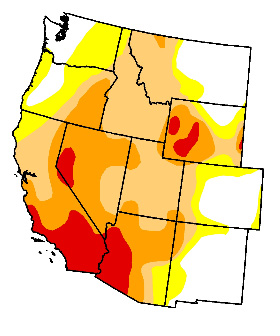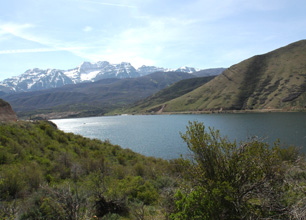Hot and Dry Year
Is Utah’s poor winter snowpack, early spring and the hot and dry summer a harbinger of a continuation of the drought?
LeRoy W. Hooton, Jr.
July 25, 2007
Last winter’s snowpack was about 50 percent of normal. Last spring hydrology specialist Larry Alserda averred that spring snowmelt was a month ahead of normal and expressed his concern about the spring runoff volumes.
“When I did the April 2007 snow surveys, I found that the two lower elevation sites were already dry and two other sites in Brighton and Alta were at, or near historical lows. The most startling observation was measuring the lowest snow ever at Mill-D in Big Cottonwood Canyon, based on 72 years of record,” said Alserda.
As the spring months turned to summer, the run-off was slightly better than expected and the reservoirs were full from the two previous wet years and good storage flows.
|
The weather pattern affecting much of the western United States has produced extreme drought conditions in southern California, western Arizona and parts of Nevada, including Las Vegas and Reno – Sierra Nevada’s areas. Los Angeles has received only 21 percent of its normal rainfall with 3.21 inches of precipitation this past year. This is the lowest amount since records have been kept. It’s been reported that precipitation in the Riverside – San Bernardino area is lower than the precipitation received in Death Valley this year.
The Colorado River continues to flow at lower than normal volumes at levels described as among the lowest in 500 years. The inflow to Lake Powell has been below normal 7 of the last 8 years. On July 10, the volume of Lake Powell storage was at 12.74 MAF or about 53 percent full. In 1999 the reservoir was full. Water stored in Lake Powell helps stabilize the level of Lake Mead by releasing water for power generation and equalizing the two reservoirs. Under the 1922 Colorado River Compact, the upper basins are required to deliver 75 MAF over a ten year period at Lee’s Ferry for use by the lower basis states. Water stored in Lake Powell is used to meet this obligation during drought periods without curtailing annual delivers to the upper basin states.
Lake Mead water levels have been in steady decline since 1998, plunging from approximately an elevation of 1212 feet to 1113 in June of 2007 – a ninety-nine foot drop in the water level in a 9 year period. Las Vegas receives 90 percent of its water supply from the lake and is constructing an additional intake in order to draw water from a lower elevation in the lake.
Over 30 million people depend on the Colorado River for their livelihood and drinking water supply, including Utah.
Most of Utah, except for the southwest and southeast portions of the state, is under moderate drought conditions. However, Utah’s drought conditions began to change with the July 10 evaluation, as the west desert slipped into severe drought conditions. If the state continues to remain dry, the drought rating could be increased.
|
According to Metropolitan Water District of Salt Lake and Sandy general manager Mike Wilson, scheduled work planned by the Bureau of Reclamation next year will require that Deer Creek Reservoir be lowered to about one-half of its capacity in order to do seismic upgrade work to the dam embankment under the overflow structure. This volume of water is available for use this year, and will be lost when the reservoir is lowered.
The public is still asked to conserve water and not waste it.

